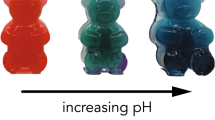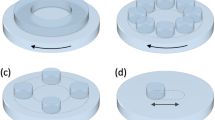Abstract
Background
The contact and frictional response of a hydrogel is dependent on the polymer structure at the gel surface. Recent work has shown that different mold materials in contact with the gel during polymerization will affect the resulting polymer density.
Objective
The tribological response of a gel with a ‘brushy’ less-dense polymer surface has not been thoroughly studied. Our goal was to perform a suite of tribological experiments to better understand the response of the less-dense layer.
Methods
In this work, we conducted indentation, creep, and sliding experiments with various loads, speeds, and probe materials to determine the impact of the less-dense layer on the contact and frictional behavior of polyacrylamide hydrogels. We additionally used micro-fluorescent particle exclusion to measure the contact areas throughout each experiment.
Results
Indentation revealed a non-Hertzian regime for the first 13–29 µm after first contact that has a weaker force response for a given indentation depth. Creep experiments showed that the surface layer relaxes poroelastically, with water exudation occurring within the gradient layer despite the low contact pressures. Friction was highly speed-dependent, with faster sliding speeds decreasing friction to values as low as 0.01; transient behavior was not seen for most of the experiments, suggesting that the surface layer is capable of quick water re-uptake when out of contact.
Conclusions
We have provided a deeper understanding of the contact and frictional response of this gradient-density surface layer, which will prove useful for hydrogel designs requiring ultra-low friction in a dynamic application.















Similar content being viewed by others
References
DeRossi D, Kajiwara K, Osada Y, Yamauchi A (1991) Polymer Gels: Fundamentals and Biomedical Applications, vol. 53
Drury JL, Mooney DJ (2003) Hydrogels for tissue engineering: Scaffold design variables and applications. Biomaterials 24(24):4337–4351. https://doi.org/10.1016/S0142-9612(03)00340-5
Calvert P (2009) Hydrogels for soft machines. Adv Mater 21(7):743–756. https://doi.org/10.1002/adma.200800534
Haque MA, Kurokawa T, Gong JP (2012) Super tough double network hydrogels and their application as biomaterials. Polymer (Guildf) 53(9):1805–1822. https://doi.org/10.1016/j.polymer.2012.03.013
Gong JP, Katsuyama Y, Kurokawa T, Osada Y (2003) Double-network hydrogels with extremely high mechanical strength. Adv Mater 15(14):1155–1158. https://doi.org/10.1002/adma.200304907
Sun JY et al (2012) Highly stretchable and tough hydrogels. Nature 489(7414):133–136. https://doi.org/10.1038/nature11409
Lin P, Ma S, Wang X, Zhou F (2015) Molecularly engineered dual-crosslinked hydrogel with ultrahigh mechanical strength, toughness, and good self-recovery. Adv Mater 27(12):2054–2059. https://doi.org/10.1002/adma.201405022
Shoaib T, Espinosa-Marzal RM (2018) Insight into the Viscous and Adhesive Contributions to Hydrogel Friction. Tribol Lett 66(3):1–14. https://doi.org/10.1007/s11249-018-1045-7
Li H, Choi YS, Rutland MW, Atkin R (2020) Nanotribology of hydrogels with similar stiffness but different polymer and crosslinker concentrations. J Colloid Interface Sci 563:347–353. https://doi.org/10.1016/j.jcis.2019.12.045
Arjmandi M, Ramezani M, Nand A, Neitzert T (2018) Experimental study on friction and wear properties of interpenetrating polymer network alginate-polyacrylamide hydrogels for use in minimally-invasive joint implants. Wear 406–407(April):194–204. https://doi.org/10.1016/j.wear.2018.04.013
Shi Y, Xiong D (2013) Microstructure and friction properties of PVA/PVP hydrogels for articular cartilage repair as function of polymerization degree and polymer concentration. Wear 305(1–2):280–285. https://doi.org/10.1016/j.wear.2012.12.020
Meier YA, Zhang K, Spencer ND, Simic R (2019) Linking Friction and Surface Properties of Hydrogels Molded against Materials of Different Surface Energies. Langmuir 35(48):15805–15812. https://doi.org/10.1021/acs.langmuir.9b01636
Gombert Y, Simič R, Roncoroni F, Dübner, Geue T, Spencer ND (2019) “Structuring Hydrogel Surfaces for Tribology,” Adv. Mater. Interfaces, vol. 6, no. 22, https://doi.org/10.1002/admi.201901320
Dunn AC, Urueña JM, Huo Y, Perry SS, Angelini TE, Sawyer WG (2013) Lubricity of surface hydrogel layers. Tribol Lett 49(2):371–378. https://doi.org/10.1007/s11249-012-0076-8
Garcia M, Schulze KD, O’Bryan CS, Bhattacharjee T, Sawyer WG, Angelini TE (2017) Eliminating the surface location from soft matter contact mechanics measurements. Tribol - Mater Surfaces Interfaces 11(4):187–192. https://doi.org/10.1080/17515831.2017.1397908
Chan EP, Hu Y, Johnson PM, Suo Z, Stafford CM (2012) Spherical indentation testing of poroelastic relaxations in thin hydrogel layers. Soft Matter 8(5):1492–1498. https://doi.org/10.1039/c1sm06514a
Lin DC, Shreiber DI, Dimitriadis EK, Horkay F (2009) Spherical indentation of soft matter beyond the Hertzian regime: Numerical and experimental validation of hyperelastic models. Biomech Model Mechanobiol 8(5):345–358. https://doi.org/10.1007/s10237-008-0139-9
Simic R, Yetkin M, Zhang K, Spencer ND “Importance of Hydration and Surface Structure for Soft-Hydrogel Friction.”
Williams DRM (1993) Moduli of Polymer Brushes, Contact Mechanics, and Atomic Force Microscope Experiments. Macromolecules 26(19):5096–5098. https://doi.org/10.1021/ma00071a018
Rubinstein M, Colby RH (2003) Polymer Physics. Oxford University Press Inc, New York
Galli M, Comley KSC, Shean TAV, Oyen ML (2009) Viscoelastic and poroelastic mechanical characterization of hydrated gels. J Mater Res 24(3):973–979. https://doi.org/10.1557/jmr.2009.0129
Lin Y-Y, Hu B-W (2006) Load relaxation of a flat rigid circular indenter on a gel half space. J Non Cryst Solids 352(38):4034–4040. https://doi.org/10.1016/j.jnoncrysol.2006.07.007
Cuccia NL, Pothineni S, Wu B, Harper JM, Burton JC (2020) Pore-size dependence and slow relaxation of hydrogel friction on smooth surfaces. Proc Natl Acad Sci U S A 117(21):11247–11256. https://doi.org/10.1073/pnas.1922364117
Schulze KD et al (2017) Biotribology Polymer Osmotic Pressure in Hydrogel Contact Mechanics. Biotribology 11(May):3–7. https://doi.org/10.1016/j.biotri.2017.03.004
Kii A, Xu J, Gong JP, Osada Y, Zhang X (2001) Heterogeneous polymerization of hydrogels on hydrophobic substrate. J Phys Chem B 105(20):4565–4571. https://doi.org/10.1021/jp003242u
McGhee EO et al (2018) “In Situ Measurements of Contact Dynamics in Speed-dependent Hydrogel Friction,” Biotribology, vol. 13, no. October 2017, pp. 23–29, https://doi.org/10.1016/j.biotri.2017.12.002
Kim J, Dunn AC (2016) Soft hydrated sliding interfaces as complex fluids. Soft Matter 12(31):6536–6546. https://doi.org/10.1039/c6sm00623j
Reale ER, Dunn AC (2017) Poroelasticity-driven lubrication in hydrogel interfaces. Soft Matter 13(2):428–435. https://doi.org/10.1039/C6SM02111E
Lai Y, He D, Hu Y (2019) Indentation adhesion of hydrogels over a wide range of length and time scales. Extrem Mech Lett 31:100540. https://doi.org/10.1016/j.eml.2019.100540
Acknowledgments
This work was supported by the National Science Foundation through NSF Award 1751945. Thank you to Jiho Kim, Shabnam Bonyadi, Md Mahmudul Hasan, and Yaswanth Sai Jetti for helpful reviews and support.
Funding
This work was supported by the National Science Foundation (Award 1751945).
Author information
Authors and Affiliations
Corresponding author
Ethics declarations
Conflict of Interest
The authors declare that they have no conflict of interest.
Additional information
Publisher's Note
Springer Nature remains neutral with regard to jurisdictional claims in published maps and institutional affiliations.
Rights and permissions
About this article
Cite this article
Johnson, C.L., Dunn, A.C. Tribological Characterization of Gradient-density Polyacrylamide Hydrogel Surfaces. Exp Mech 61, 829–842 (2021). https://doi.org/10.1007/s11340-021-00704-x
Received:
Accepted:
Published:
Issue Date:
DOI: https://doi.org/10.1007/s11340-021-00704-x




